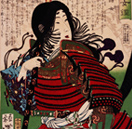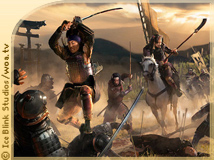
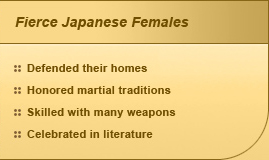
One who is samurai must, before all things, keep constantly in mind, by day and by night ... that he has to die.
—Daidoji Yuzan, sixteenth-century samurai
Did female samurai exist? Literally speaking, the answer is no.
“Samurai” is a gender-specific word that comes from the Japanese verb meaning “to serve” and refers to male members of the buke, an elite Japanese military class. So, strictly speaking, “female samurai” is a misnomer. Yet it is known that the buke women fought fiercely to defend their homes while their samurai husbands were at war. While the courage and ferocity of these domestic defenders cannot be denied, there are only a few legendary records of professional female warriors who fought in wars and could be considered equivalent to samurai. These fighters have become folk heroes, immortalized in centuries of legends, plays and poems.
Warriors for Hire
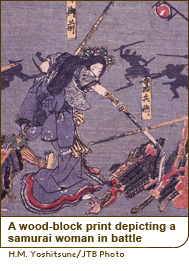
For more than six hundred years, the samurai ruled Japan. This fighting class effectively governed the country from the end of the Heian period (794–1185 CE), when wealthy landowners hired private warriors to protect their property, until 1868, when Japan’s feudal era ended and the samurai were abolished.
The main role of buke wives was to care for their children and warrior husbands. During the Kamakura period (1185–1333 CE), the women had to make certain that their children were raised in the samurai code, with a disdain for death and absolute loyalty to their lord. With husbands gone for long periods, women often controlled their entire households, from finances to staff.
In 1467, Japan entered a chaotic period of warring states. The rampant bloodshed put the samurai in great demand, and their wives were often left as the last defense for their homes. Far from helpless, the typical buke woman was highly skilled in martial arts, intensely loyal and willing to die to protect her family. These lethal females were referred to as onna bugei-sha, which translates as “an accomplished female of the military,” and were expected to physically defend their homes and their children from raiders when their samurai husbands were absent.
Killers in Kimonos
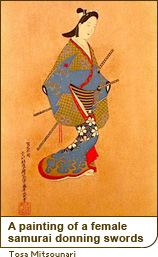 An onna bugei-sha’s naginata would hang inside the door of her house so it was easily accessible if her home came under attack. Women favored the naginata because of its size. The long pole allowed them to keep their male foes at a distance. Buke women were also trained to pierce an attacker’s chest or throat with kansashi, the long pins used primarily to keep a woman’s hair in place. It took considerable strength and skill for these women to battle invaders while wearing the cumbersome double layers of a silk kimono and traditional thonged straw sandals.
An onna bugei-sha’s naginata would hang inside the door of her house so it was easily accessible if her home came under attack. Women favored the naginata because of its size. The long pole allowed them to keep their male foes at a distance. Buke women were also trained to pierce an attacker’s chest or throat with kansashi, the long pins used primarily to keep a woman’s hair in place. It took considerable strength and skill for these women to battle invaders while wearing the cumbersome double layers of a silk kimono and traditional thonged straw sandals.
If defeat was imminent, onna bugei-sha hid kaiken under their kimonos. Rather than being captured, they used the weapon to perform jigai, an honorable form of suicide in which a woman would cut her own jugular vein. Jigai brought death quickly, saving women from the ugly grimace often frozen on the faces of men who committed seppuku, a ceremonial disembowelment. The women were encouraged to bind their feet together before committing jigai so that their legs would not be thrown into an immodest position by death throes.
Although it is documented that buke women fought valiantly to protect their families, the great chronicles of the wars of the Heian, Kamakura and Muromachi periods focus mostly on the deeds of the male samurai; official women warriors are rarely mentioned. Women, in fact, are often depicted as being butchered in raids or given to the enemy as spoils of war.
Legendary Onna-Musha
Women who fought professionally alongside the samurai in war, properly referred to as onna-musha, or female warriors, are only highlighted in legendary accounts. Two such onna-musha were Tomoe Gozen and Itagaki. Both are featured in the Heike Monogatari (Tale of the Heike), the great medieval samurai epic that, like Homer’s Iliad in ancient Western literature, merges legend with history. While neither Tomoe Gozen nor Itagaki has been proven to be a historical figure, they both embody the fierce determination of the women of the buke warrior class.
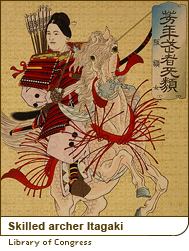 Tomoe Gozen was the beautiful wife of General Kiso Yoshinaka. A courageous warrior and amazing horsewoman, deadly with both sword and bow, Tomoe served under Minamoto Yoshinaka in the Gempei War (1180–1185 CE). She rode into battle and fought as fearlessly as any samurai, often taking on the most dangerous missions.
Tomoe Gozen was the beautiful wife of General Kiso Yoshinaka. A courageous warrior and amazing horsewoman, deadly with both sword and bow, Tomoe served under Minamoto Yoshinaka in the Gempei War (1180–1185 CE). She rode into battle and fought as fearlessly as any samurai, often taking on the most dangerous missions.
Itagaki (also known as Hangaku Gozen), famous for her skill with a bow and arrow, was from a warrior family of Echigo province. In 1201 CE, when the Echigo warriors besieged the Tossaka castle, Itagaki fought bravely until, with severe wounds in both legs, she was taken prisoner and presented before the shogun Yoriie. Itagaki was spared by the shogun and courted by Yoshito Asari of the Kai Genji, who was taken by her bravery and beauty. Some accounts have them living happily ever after in peace. (Whether the marriage was by choice or forced is unknown.) Others say she died in battle defending Torizakagama castle.
The End of the Samurai
In 1868, the imperial forces set out to eradicate the last of the samurai. When the samurai of the Aizu clan found themselves heavily outnumbered, a small band of their women fought with them to the end. One of them, Nakano Takeko, a woman highly skilled with the naginata, attacked the enemy lines, fighting heroically until she was shot in the chest and killed.
Over the centuries, the status of the samurai wives and daughters faded away. Due to the influence of neo-Confucian philosophy, the wifely ideal of fearless devotion was slowly replaced by one of passive obedience. But the courageous deeds of buke women live on in the tales of its famous onna-musha—embodying bravery in battle, contempt for death and fierce dedication to warlike customs that defined the samurai of their warrior class.
:: Lisa Cooke
Samurai Selected Sources


